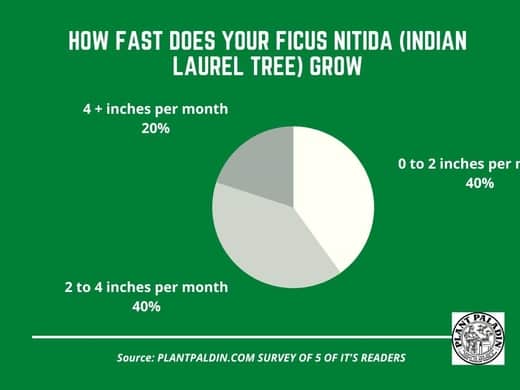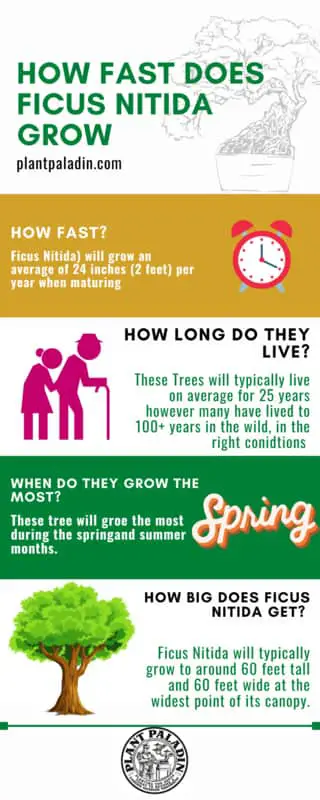This website is supported by its readers. If you click one of my links I may earn a commission. I am also a participant in the Amazon affiliates program and I will also earn a commission from qualified purchases.

Ficus trees are easily one of the most versatile tree species available. One such subspecies that are incredibly popular are Ficus Microcarpa – commonly referred to as Ficus Nitida. Now I’ve been thinking of purchasing a Ficus Nitida for a few months to add to my bonsai collection, and so one question I have is how fast does Ficus Nitida grow?
Ficus Nitida (also known as Ficus Microcarpa) will grow an average of 24 inches (2 feet) per year when maturing. This tree can reach up to 60 feet high in 15 to 20 years.
So why is it important to know how fast Ficus Nitida grows? And are there any methods you can follow to help your Ficus Nitida grow faster or slower? Keep reading to find out more!
Just a quick heads up, over the past three years of running Plantpaladin, hundreds of people have asked for product recommendations. As such, You can find my favorite indoor bonsai tree here (link takes you to Bonsaiboy), my favorite outdoor bonsai tree (link takes you to Bonsaiboy), or have a look at all the products I recommend here.
How fast does Ficus Nitida grow?
One of the things that always surprises me about the different Ficus is how different they grow when compared to each other.
Ginseng Ficus, which I primarily use for bonsai, will only grow a few inches per year compared to my weeping Ficus, which can increase a foot or more.
I’ve been thinking about adding a new Ficus Nitida tree (also known as Chinese Bayan, Malaysian Bayan, Curtain Fig, and Indian Laurel trees) to my collection.
Finding out how fast a Ficus Nitda tree grows is on the top of my to-do list.
I got in touch with five plant paladin readers who also grow this variety of Ficus, asked a few local tree experts, and even went to my local botanical gardens and asked them how fast does a Ficus Nitida grow.
All to ensure you have the most comprehensive post on the web on the topic.
To summarise:
How fast does Ficus Nitida grow – quick facts
- Most Ficus Nitida trees will grow 24 inches per year (2 feet or 61cm) when maturing.
- Ficus Nitida trees will grow the fastest in their first five years. These trees can add upwards of 50 to 60 inches of growth per year in these first five years.
- Things will then slow down to about 24 inches of growth per year.
- Ficus Nitida will grow to about 60 feet tall and 60 feet wide before it stops growing if kept in a warm, dry, or tropical climate.
- These trees then will stop growing from around the 20 to 25-year mark.
- The roots of a Ficus Nitida tree will also typically grow the same amount.
- If used for a hedge, Ficus Nitida should be kept at about 10 to 30 feet.
- If using Ficus Nitida for bonsai, aim to keep a medium-sized tree about 3 feet or one-meter tall for best results.
- These trees will grow the fastest outdoors in dry, warm conditions during the spring/summer-like all Ficus. They can be grown indoors but may not grow as fast or as high as their outdoor counterparts in the right conditions.
How fast does Ficus Nitida grow during the seasons?
Ficus Nitida, like most other Ficus species, is evergreen/semi-deciduous.
During the colder fall and winter, they will continue to grow and not shed their leaves.
The growth these trees experience, however, will vary greatly year-round.
When the tree’s energy levels are at their highest during the spring and summer, they will grow faster than during the dormant fall and winter months.
Let’s break down the growth season by season:
How fast does a Ficus Nitida grow during the spring?
Ficus Nitida will grow the most during the spring, as there is the most energy in the plant.
You can expect your tree to start blooming figs during this time.
During the spring or March to May, these trees will grow between 3 to 4 inches per month.
How fast does a Ficus Nitida grow during the summer?
Ficus Nitida loves warm conditions, and so in the summer, these trees will also grow between three and four inches per month.
How fast does a Ficus Nitida grow during the fall?
These trees will start to slow down their growth rate during the fall. Expect Ficus Nitida then to only grow between 1 and 2 inches between September to November.
How fast does a Ficus Nitida grow during the winter?
While Ficus Nitida is an evergreen subspecies of Ficus, don’t expect these trees to grow a lot during the winter.
These trees love bright sunlight and warm weather, and so during winter, expect these trees do not grow during the winter.
To help put these timescales in perspective, hopefully, the table below will help:
Season | Growth |
Spring | 2 to 4 inches |
Summer | 2 to 4 inches |
Fall | 1 to 2 inches |
Winter | 0 |
How fast does a Ficus Nitida grow during its life?
As mentioned earlier in the post, depending on what life stage the tree is at will determine how fast this tree grows.
The younger a Ficus Nitida tree is, the more it will grow compared to an older Ficus Nitida tree.
0 to 5 years
Ficus Nitida will grow the most during the first five years.
If kept in the right conditions, Ficus Nitida trees that are five years or less average between 40 to 60 inches of growth per year or 3 to 5 inches of growth per month.
This growth will mean that your Ficus Nitida will reach around 240 inches (5 meters) to 300 inches (7 meters) in height after five years.
5 to 15 years
In the following ten years of your Ficus Nitida’s life, you can expect your tree to grow 2 inches per month or 24 inches per year.
Most people who own Ficus Nitida have a tree between 5 and 15 years old and so you can expect this much growth year-round.
If you keep your Ficus Nitida for use as a hedge, you will top prune your hedge about once per month to prevent any excess growth.
15 to 25 years
Your tree has likely reached maturity and, if grown in the right conditions, will be around 40 to 60 feet tall.
If this is the case, your tree will become less efficient at growing, and you can expect your tree to add another 10 inches of growth per year until your tree hits 20 to 25 years old.
25 years +
The fact of the matter is that many Ficus Niitada species don’t often make it past 25 years if growing from scratch ourselves.
This lack of growth s mainly due to many of us not living in a suitable climate for these trees.
If your Ficus Nitida has made it to 25 years, you can expect an additional two to three inches of new growth per year.
Age Range (Years) | Growth (per year) |
0-5 | 40 to 60 inches |
5 to 15 | 24 inches |
15 to 25 | 10 to 24 inches |
25+ | 2 to 3 inches |
How to speed up the growth of a Ficus Nitida
So now we know how much a Ficus Nitida grows; you can compare your tree against the general guidelines.
If you find that your tree is lagging behind the growth it should be achieving; you can do a few things to speed up the development of your Ficus Nitida.
These include:
Maintain the right temperature
The biggest reason your tree might not be growing as fast as you want it to is that you live in a cooler climate.
In the wild, Ficus Nitida, or any other Ficus species, originates from warmer climates and needs a lot of heat to thrive.
Ficus Nitida is commonly referred to as the Indian Laurel tree, and so as you can imagine, you will need a lot of heat.
These trees typically need to be kept at temperatures then between 60 and 100 degrees F, so if you live in a cooler climate such as the UK or the northern states in the USA, you will need to maintain the right temperature.
There are a few ways to do this.
First, move your tree indoors.
One of the reasons why Ficus trees make for great indoor trees is that the warmer temperatures usually suit them best.
If you don’t have space indoors, consider moving your tree into a greenhouse or a homemade greenhouse that can cost considerably less.
Ensure the tree gets enough sunlight
So sadly, it’s not just warmer temperatures Ficus Nitida requires but a lot of sunlight too.
On average, Ficus trees need around 4 to 6 hours of direct sunlight per day.
Aim to move these trees into the brightest part of your garden if possible.
If you have planted your tree in the ground, repot and relocate it; while it will be a pain to move, failing to do so will mean having a sub-standard tree.
If you have followed the advice and moved your tree indoors, fret not.
Move your tree near a south- or west-facing windowsill to ensure it gets a lot of light.
Alternatively, invest in artificial LED light with a full-color spectrum to ensure your tree meets its light needs.
Water during the early part of your tree’s life
Ficus Nitida is unique because they do not require as much water as other tree species.
Typically watering once per week will be fine for the tree.
However, the only exception to this will be if your tree is in its first year or two.
Your tree needs to be watered much more frequently during these earlier years before it becomes drought tolerant.
You should check your Ficus Nitida every day during the first year or two to see if it needs watering.
The best method will be to only water if the soil is dry to touch; if so, water the tree.
Now the older the tree gets, you should stick to watering only once per week as doing so more frequently can overwater the tree.
Water with regular tap water or, better yet, rainwater for best results.
Remove any pests or infections.
So if you have followed the methods above but are still finding that your tree is not growing as it should be, then your tree might be unhealthy.
This lack of growth could be due to bacterial infections, but with Ficus trees, this is commonly due to bugs like Aphids, Scale, Caterpillar, or Spider Mites attacking your tree.
Luckily, liquid soap can quickly resolve insect infestation if caught early enough.
To do so, spray your tree with a bottle full of water and a tablespoon of liquid soap.
Now a more serious side effect as to why your Ficus Nitida does not grow fast is because of a mold, bacterial or fungal infection such as Canker.
Mold infections are spotted with things like orange or white spots on your tree’s leaves.
How fast does Ficus Nitida bonsai grow?
Ficus Nitida is commonly used in bonsai trees, so it would be good to get an idea of the speed of these trees.
Ficus Nitida is a relatively slow-growing bonsai tree species and adds around 1 to 2 inches of growth per month.
These trees will grow at a slightly slower rate than regular Ficus Nitida species due to the miniaturization process associated with bonsai.
If used in bonsai, these trees should be kept top a medium seized, one or two hand tree about a meter tall for best results.
How fast does a Ficus Nitida hedge grow?
A Ficus Nitida hedge will grow between 2 and 4 inches per month during the spring, summer, and fall. As such, prune once per month to avoid your hedge becoming overgrown.
For best results, Ficus Nitida hedges should be kept between 10 and 30 feet.
How big does Ficus Nitida get?
Ficus Nitida will typically grow to around 60 feet tall and 60 feet wide at the widest point of its canopy. If grown in the right conditions with care Ficus Nitida roots will typically reach between 50 and 560 feet.
Does Ficus Nitida grow faster indoors or outdoors?
Like most trees, Ficus Niitida will grow better outdoors in its natural environment than kept indoors.
With so many people keeping these trees in cooler climates, the only way these trees will live in these conditions is if they are kept indoors.
As such, ensure to keep these trees indoors if you live in a location where the outdoor temperature drops below 60 degrees Fahrenight (15.5 degrees celsius)
Why is it important to know the growth of the Ficus Nitida?
It’s essential to know the growth rate of India Laural/Ficus Nitida trees, as these trees can cause damage to their surrounding structures.
It’s common for the roots of these trees to grow between 50 and 60 feet.
As such, in hardiness zones, 9 through 12, that have already been weekend by colder temperatures, or older building materials will be quickly upended by these Ficus trees roots.
The roots of these trees do not go that deep and are near the surface of any potting soil and so knowing how fast these trees grow will allow you to plan any nearby sidewalks, sewage works, or pathways that these trees might impact.
Survey on how fast does Ficus Nitida grow?
So as mentioned, I asked five plant paladin readers how much their Ficus Nitida trees grow per year – here are the results.

How to care for a Ficus Nitida?
Finally, many of you reading this will be doing so to find out exactly how to care for the Ficus Nitida you have just purchased.
Luckily caring for these trees is very similar to Ginseng Ficus, and so the table below should prove helpful:
Ginseng Ficus Bonsai tree Requirements | Explained |
Water | Once per day in the spring-summer or if kept indoors. Once per week if kept outdoors during the winter. Only water if dry to touch. |
Sunlight | 4 hours of direct sunlight in the summer. LED grow light can also be used. |
Temperature | Between 60 degrees F and 100 degrees F |
Fertilizer | Fertilize 18 times per year, twice per month between spring and summer. Once per month in the fall and winter |
Repotting | Once every 2 to 3 years in the first 10 years. You can then report once every 5 years |
Placement | Can be placed outdoors in direct sunlight or indoors in a bright spot. |
Wire type | Both copper and aluminum wire can be used. |
Time to grow from scratch into maturity | 8 to 12 years to reach full maturity |
Potting soil | An inorganic Akdama, volcanic ash soil mix works best. |
Growth type | Slow growing, averaging 3-5 inches per year |
Size | Average store-bought trees are size is one or two-handed bonsai trees - 3 to 10 inches in size, 2 to 8 inches wide |
Lifespan | 50 to 150 years |
Fruit | figs |
I’d also recommend checking out the following posts, which you also might find of benefit:
- How to take care of a fake ficus tree
- How to Straighten a Ficus tree
- Do Ficus trees like Coffee grounds?
- Are Ficus trees toxic to cats?
My top picks for the gear you will need!
So like I mentioned earlier, over the past three years of running PlantPaladin, hundreds of people have asked me for my recommendations on the best bonsai gear on the market.
Having spent thousands of dollars on bonsai items these past few years and tested at least 100 bonsai-specific products, I’ve listed my favorite products below – All of which I highly recommend and think you can get great value.
They can purchase directly by clicking the link to take them to Amazon.
Bonsai Tool Set: One of the significant challenges I’ve had is finding a toolset that was not only durable but didn’t break the bank. SOLIGT has recently developed a fantastic bonsai tool set that covers all the tools you need to trim, prune, and repot your trees. – You can grab it here.
Complete Bonsai Set: Many of you will want to grow your bonsai trees entirely from scratch, but finding the varicose seeds, pots, and other items in one place can be challenging. Leaves and Sole then have created a complete bonsai set that I’ve personally used that ticks all the boxes. You can grab it here.
Bonsai wire: The number of times I’ve run out of wire for my bonsai or purchased cheap bonsai wire that doesn’t do the job is embarrassing for me to admit. After a lot of trial and error, I found that using Hotop’s aluminum bonsai wire is one of the best options on the market. This can easily be used for both indoor and outdoor bonsai. You can grab it here.
This post was written by Fehed Nicass who has been passionate about bonsai for over 3 years. He currently resides in the UK and works in sales

